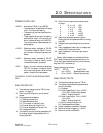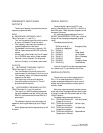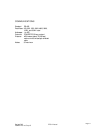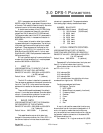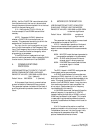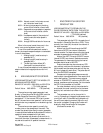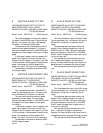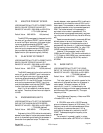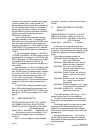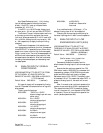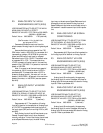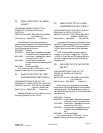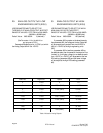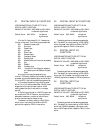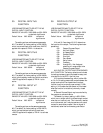Page 23
Revised 7/95 DFS-1 Manual
POWERTEC Ind. Corp.©
tionship between motor speed and EGU is defined in
parameter #14, which sets the value of EGU’s at full
motor speed. This parameter is used to determine the
relationship between units of commanded speed and
RPM. The number entered in this parameter is
equivalent to the number in parameter #6. This
allows the user to enter speed commands in engineer-
ing units (such as Feet Per Minute, Yards Per Minute,
etc).
Speed commands entered by commands #82 and
#84 are entered in terms of this parameter. If the
value of this parameter is the same as the value of
parameter #6, then there is a 1:1 relationship between
the Engineering Units and the RPM (i.e., enter 1750
(06D6h) as a speed command for 1750 RPM).
However, if this parameter is set to 1000
(03E8h) and #6 is set to 1750, then the relationship is
1:1.75. Entering 1000 (03E8h) as a command results
in 1750 RPM, but entering 500 (01F4h) results in
875 RPM.
15. BASE RATIO
USE PARAMETER #15 TO SET THE “GEAR
RATIO” OF THE MOTOR IN A SLAVE SYSTEM.
RANGE OF VALUES: 0000 0001h to 0001 869Fh
1 TO 99,999 (decimal)
Default Value: 0000 2710h 10,000 (decimal)
This is the “gearing” ratio which corrects for the
mechanics of the system and also for differences in
motor speeds. The output frequency at TB2:B
terminals 10 (+) and 11(-) is determined by the
settings of the maximum motor speed (parameter #6)
and the encoder PPR (parameter #7). The output
frequency will be:
Output Reference Frequency = Motor max RPM
x Encoder PPR x 16 / 60
A 1750 RPM motor with a 120 PPR encoder
puts out a reference frequency of 56 Kilohertz. This
frequency varies with the commanded speed. When
this frequency is used as a reference, it is first
multiplied by the base ratio, and then by the SET-
POINT. These steps change the frequency to the
proper level.
For example, it is generally useful in a slave
system to be able to enter a SETPOINT of 1.0000 on
12. MASTER PRESET SPEED
USE PARAMETER #12 TO SET A PRESET SPEED
WHICH CAN BE TOGGLED IN AND OUT.
RANGE OF VALUES: 0000 0000h to 0000 2710h
0 TO 10,000 (decimal)
Default Value: 0000 00C8h 100 (decimal)
The MASTER preset speed is the speed to which
the motor will go when a PRESET input is activated
on one of the Digital inputs (any of the seven digital
inputs may be programmed as a PRESET input)
when the DFS-1 is in the MASTER mode. If more
than one input is programmed as a PRESET input,
they must both be present to activate the PRESET
Speed function (the inputs are logically ANDed).
13. SLAVE RATIO PRESET
USE PARAMETER #13 TO SET A PRESET RATIO
WHICH CAN BE TOGGLED IN AND OUT.
RANGE OF VALUES: 0000 0000h to 0001 869Fh
0 TO 99,999 (decimal)
Default Value: 0000 2710h 10,000 (decimal)
The SLAVE preset ratio is the ratio to which the
motor will go when a PRESET input is activated on
one of the Digital inputs (any of the seven digital
inputs may be programmed as a PRESET input)
when the DFS-1 is in the SLAVE mode. If more than
one input is programmed as a PRESET input, they
must both be present to activate the PRESET Speed
function (the inputs are logically ANDed).
Note: For all ratio setpoints, 4 decimal places
are implied. Therefore, the maximum ratio setpoint
is 9.999.
14. ENGINEERING UNITS
USE PARAMETER #14 TO SET THE ENGINEER-
ING UNITS AT MAXIMUM MOTOR SPEED.
RANGE OF VALUES: 0000 0001h to 0001 869Fh
1 TO 99,999 (decimal)
Default Value: 0000 06D6h 1750 (decimal)
Engineering Units (EGU) define the relationship
between motor speed or torque and process reference
points. It allows setting and reading of parameters in
terms other than speed and torque. The basic rela-



